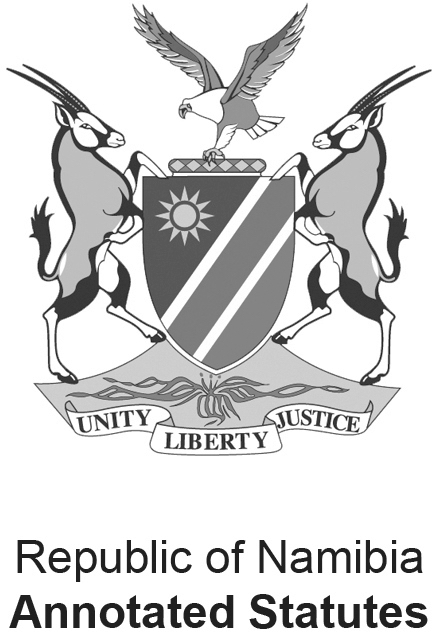This Government Notice was repealed on 2017-11-23 by Animal Identification Regulations, 2017.

Animal Health Act, 2011
Animal Identification Regulations, 2009
Government Notice 29 of 2009
- Published in Government Gazette 4217 on 5 March 2009
- Commenced on 5 March 2009
- [This is the version of this document at 15 November 2017.]
- [Note: The version of this legislation as at 15 November 2017 was revised and consolidated by the Legal Assistance Centre and the Government of the Republic of Namibia. All subsequent amendments have been researched and applied by Laws.Africa for NamibLII.]
- [Repealed by Animal Identification Regulations, 2017 (Government Notice 307 of 2017) on 23 November 2017]
1. Definitions
In these regulations, unless the context otherwise indicates, a word or expression defined in the Act has the same meaning and-“administrator” means the administrator of the distribution of identification devices designated or appointed under regulation 12(1);“animal gathering” means an event at which animals from different establishments are brought together for sale, show, exhibition, inspection, onward consignment or any other purpose;“approved device” means a tag, mark, transponder or other device approved by the director under regulation 11 for the identification of a designated animal;“approved form” means a form approved by the director to be used for the purposes of these regulations;“central database” means the central database in respect of designated animals established under regulation 25(1);“designated animal” means an animal of the species cattle, sheep, goats or pigs;“establishment” means any land, premises or place, including any part of any land, premises or place;“licensee” means the holder of a licence issued under regulation 8 in respect of an establishment licensed for the holding of an animal gathering;“manager of the central database” means the manager of the central database designated or appointed under regulation 25(2).[GN 5/2011, which amends regulations 16 and 31 and inserts regulation 31A, includes a definition for “veterinary cordon fence”, without actually amending regulation 1 on definitions:“‘veterinary cordon fence’ means the fence which divides the veterinary buffer zone and the veterinary surveillance zone, commencing at Palgrave Point on the west coast of Namibia and running in a generally eastern direction to a point on the common border between the Republic of Namibia and the Republic of Botswana at 20 degree latitude.”]
2. Purpose
The purpose of these regulations is to help the prevention, control and eradication of animal disease and parasites by implementing a livestock identification and traceability system through requirements that create the capacity to trace the origin, movements and fate of designated animals.Part I – HOLDING OR KEEPING OF DESIGNATED ANIMALS
3. Notification of holding or keeping of designated animal
4. Manner of notification
5. Registration of establishment and allocation of herd or flock identification code
6. Notification of change
Part II – ANIMAL GATHERINGS
7. Licensing of an establishment for animal gathering
8. Application for licence
9. Approval required for animal gathering
10. Prohibition or restriction of animal gatherings
Part III – ANIMAL IDENTIFICATION
11. Approval of identification devices
12. Administrator of distribution of identification devices
13. Requirements in respect of approved ear tags
14. Obligations with respect to supply or use of approved device
15. Power to conduct inspection
For the purposes of determining whether subregulation (1) or (2) of regulation 14 is being or has been complied with by the administrator or the manufacturer or distributor of an approved device, an officer or authorised person may-16. Identification of cattle
17. Identification of sheep and goats
18. Identification of pigs
19. Identification of imported designated animals
20. Replacement of approved device
21. Replacing approved device with different number
22. Alteration or removal of approved device
23. Safekeeping of unused approved devices
24. Identification of carcass or meat or offal of slaughtered animal
If so required by a State veterinarian, the operator of an abattoir must cause the carcass of a slaughtered designated animal, or the meat or offal derived from that carcass, to be marked or labelled in a manner approved by the State veterinarian so as to facilitate the tracing of the carcass, or the meat or offal back to the animal or the group of animals from which it was taken.Part IV – ANIMAL REGISTRATION AND KEEPING OF REGISTERS
25. Central database
26. Cattle to be registered on central database
27. Imported designated animals to be registered on central database
28. Keeping of livestock register
29. Keeping of individual animal register
30. Keeping of register of imported designated animals
Part V – MOVEMENT OF DESIGNATED ANIMAL
31. Permit required for movement of designated animals
31A. commits an offence
32. Sending of movement permit by electronic means
33. Notification of movement of designated animals
34. Notification of death, theft or stray of individually identified animal
35. Notification of slaughter at abattoirs
Part VI – GENERAL
36. Penalties
A person who is convicted of committing an offence under these regulations is liable to the penalties set out in section 28(1)(p)(ii) of the Act.History of this document
23 November 2017
Repealed by
Animal Identification Regulations, 2017
15 November 2017 this version
Consolidation
05 March 2009
Commenced